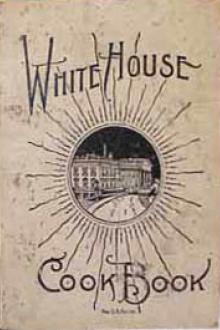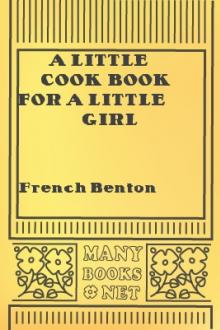The Whitehouse Cookbook (1887), Hugo Ziemann [world of reading .TXT] 📗

- Author: Hugo Ziemann
- Performer: -
Book online «The Whitehouse Cookbook (1887), Hugo Ziemann [world of reading .TXT] 📗». Author Hugo Ziemann
Have apple sauce to eat with them.
Pork cutlets prepared in this manner may be stewed instead of being fried. Add to them a little water, and stew them slowly till thoroughly done, keeping them closely covered, except when you remove the lid to skim them.
PORK CHOPS AND FRIED APPLES.
Season the chops with salt and pepper and a little powdered sage; dip them into bread crumbs. Fry about twenty minutes or until they are done. Put them on a hot dish; pour off part of the gravy into another pan to make a gravy to serve with them, if you choose. Then fry apples which you have sliced about two-thirds of an inch thick, cutting them around the apple so that the core is in the centre of each piece; then cut out the core. When they are browned on one side and partly cooked, turn them carefully with a pancake turner, and finish cooking; dish around the chops or on a separate dish.
FRIED PORK CHOPS.
Fry them the same as mutton chops. If a sausage flavor is liked, sprinkle over them a little powdered sage or summer savory, pepper and salt, and if a gravy is liked, skim off some of the fat in the pan and stir in a spoonful of flour; stir it until free from lumps, then season with pepper and salt and turn in a pint of sweet milk. Boil up and serve in a gravy boat.
PORK PIE.
Make a good plain paste. Take from two and a half to three pounds of the thick ends of a loin of pork, with very little fat on it; cut into very thin slices three inches long by two inches wide; put a layer at the bottom of a pie-dish. Wash and chop finely a handful of parsley, also an onion. Sprinkle a small portion of these over the pork, and a little pepper and salt. Add another layer of pork, and over that some more of the seasoning, only be sparing of the nutmeg. Continue this till the dish is full. Now pour into the dish a cupful of stock or water, and a spoonful or two of catsup. Put a little paste around the edge of the dish; put on the cover and place the pie in a rather hot oven. When the paste has risen and begins to take color, place the pie at the bottom of the oven, with some paper over it, as it will require to be baked at least two hours. Some prefer to cook the meat until partly done, before putting into the crust.
PORK POT-PIE.
Take pieces of ribs of lean salt pork, also a slice or two of the fat of salt pork; scald it well with hot water so as to wash out the briny taste. Put it into a kettle and cover it with cold water, enough for the required want. Cover it and boil an hour, season with pepper; then add half a dozen potatoes cut into quarters. When it all commences to boil again, drop in dumplings made from this recipe:—
One pint of sour or buttermilk, two eggs, well beaten, a teaspoonful of salt, a level teaspoonful of soda; dissolve in a spoonful of water as much flour as will make a very stiff batter. Drop this into the kettle or broth by spoonfuls, and cook forty minutes, closely covered.
PORK AND BEANS. (Baked.)
Take two quarts of white beans, pick them over the night before, put to soak in cold water; in the morning put them in fresh water and let them scald, then turn off the water and put on more, hot; put to cook with them a piece of salt pork, gashed, as much as would make five or six slices; boil slowly till soft (not mashed), then add a tablespoonful of molasses, half a teaspoonful of soda, stir in well, put in a deep pan, and bake one hour and a half. If you do not like to use pork, salt the beans when boiling, and add a lump of butter when preparing them for the oven.
BOSTON PORK AND BEANS.
Pick over carefully a quart of small, white beans; let them soak over night in cold water; in the morning wash and drain in another water. Put on to boil in plenty of cold water with a piece of soda the size of a bean; let them come to a boil, then drain again, cover with water once more, and boil them fifteen minutes, or until the skin of the beans will crack when taken out and blown upon. Drain the beans again, put them into an earthen pot, adding a tablespoonful of salt; cover with hot water, place in the centre a pound of salt pork, first scalding it with hot water, and scoring the rind across the top, a quarter of an inch apart to indicate where the slices are to be cut. Place the pot in the oven, and bake six hours or longer. Keep the oven a moderate heat; add hot water from the tea-kettle as needed, on account of evaporation, to keep the beans moist. When the meat becomes crisp and looks cooked, remove it, as too long baking the pork destroys its solidity.
FRIED SALT PORK.
Cut in thin slices, and freshen in cold water, roll in flour, and fry crisp. If required quickly pour boiling water over the slices, let stand a few minutes, drain and roll in flour as before; drain off most of the grease from the frying pan; stir in while hot one or two tablespoonfuls of flour, about half a pint of milk, a little pepper, and salt if over freshened; let it boil, and pour into a gravy dish. A teaspoonful of finely-chopped parsley will add pleasantly to the appearance of the gravy.
GRILLED SALT PORK.
Take quite thin slices of the thick part of side pork, of a clear white, and thinly streaked with lean; hold one on a toasting fork before a brisk fire to grill; have at hand a dish of cold water, in which immerse it frequently while cooking, to remove the superfluous fat and render it more delicate. Put each slice as cooked in a warm covered pan; when all are done, serve hot.
FRIED HAM AND EGGS.
Cut slices of ham quite thin, cut off the rind or skin, put them into a hot frying pan, turning them often until crisp, taking care not to burn the slices; three minutes will cook them well. Dish them on a hot platter; then turn off the top of the grease, rinse out the pan, and put back the clear grease to fry the eggs. Break the eggs separately in a saucer, that in case a bad one should be among them it may not mix with the rest. Slip each egg gently into the frying pan. Do not turn them while they are frying, put keep pouring some of the hot lard over them with a kitchen spoon; this will do them sufficiently on the upper side. They will be done enough in about three minutes; the white must retain its transparency so that the yolk will be seen through it. When done take them up with a tin slice; drain off the lard, and if any part of the white is discolored or ragged, trim it off. Lay a fried egg upon each slice of the ham, and send to table hot.
COLD BACON AND EGGS.
An economical way of using bacon and eggs that have been left from a previous meal is to put them in a wooden bowl and chop them quite fine, adding a little mashed or cold chopped potato, and a little bacon gravy, if any was left. Mix and mould it into little balls, roll in raw egg and cracker crumbs, and fry in a spider the same as frying eggs; fry a light brown on both sides. Serve hot. Very appetizing.
SCRAPPEL.
Scrappel is a most palatable dish. Take the head, heart and any lean scraps of pork, and boil until the flesh slips easily from the bones. Remove the fat, gristle and bones, then chop fine. Set the liquor in which the meat was boiled aside until cold, take the cake of fat from the surface and return to the fire. When it boils put in the chopped meat and season well with pepper and salt. Let it boil again, then thicken with corn meal as you would in making ordinary corn meal mush, by letting it slip through the fingers slowly to prevent lumps. Cook an hour, stirring constantly at first, afterwards putting back on the range in a position to boil gently. When done, pour into a long, square pan, not too deep, and mould. In cold weather this can be kept several weeks. Cut into slices when cold, and fried brown, as you do mush, is a cheap and delicious breakfast dish.
TO BAKE A HAM. (Corned.)
Take a medium-sized ham and place it to soak for ten or twelve hours. Then cut away the rusty part from underneath, wipe it dry, and cover it rather thickly over with a paste made of flour and water. Put it into an earthen dish, and set it in a moderately heated oven. When done, take off the crust carefully, and peel off the skin, put a frill of cut paper around the knuckle, and raspings of bread over the fat of the ham, or serve it glazed and garnished with cut vegetables. It will take about four or five hours to bake it.
Cooked in this way the flavor is much finer than when boiled.
PIGS' FEET PICKLED.
Take twelve pigs' feet, scrape and wash them clean, put them into a saucepan with enough hot (not boiling) water to cover them. When partly done, salt them. It requires four to five hours to boil them soft. Pack them in a stone crock, and pour over them spiced vinegar made hot. They will be ready to use in a day or two. If you wish them for breakfast, split them, make a batter of two eggs, a cup of milk, salt, a teaspoonful of butter, with flour enough to make a thick batter; dip each piece in this and fry in hot lard. Or, dip them in beaten egg and flour and fry. Souse is good eaten cold or warm.
BOILED HAM.
First remove all dust and mold by wiping with a coarse cloth; soak it for an hour in cold water, then wash it thoroughly. Cut with a sharp knife the hardened surface from the base and butt of the ham. Place it over the fire in cold water, and let it come to a moderate boil, keeping it steadily at this point, allowing it to cook twenty minutes for every pound of meat. A ham weighing twelve pounds will require four hours to cook properly, as underdone ham is very unwholesome. When the ham is to be served hot, remove the skin by pealing it off, place it on a platter, the fat side up, and dot the surface with spots of black pepper. Stick in also some whole cloves.
If the ham is to be served cold, allow it to remain in the pot until the water in which it was cooked becomes cold. This makes it more juicy. Serve it in the same manner as when served hot.
BROILED HAM.
Cut your ham into thin slices, which





Comments (0)